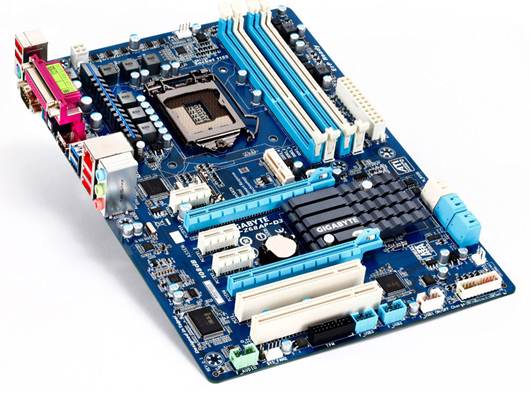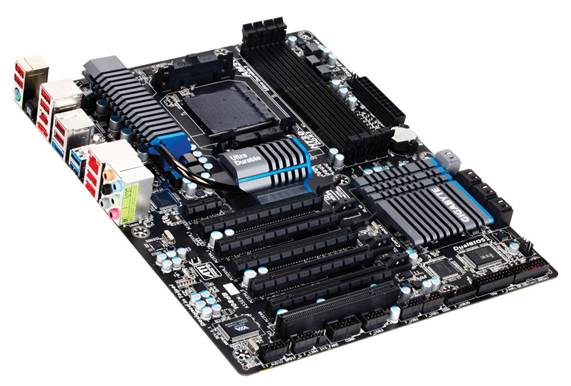Want a motherboard but don't know
what your cash will buy guide, we'll help you choose the right
When you’re building a system, choosing the
right motherboard is an essential part of the puzzle. Its capabilities may not
to be impressive its own right, but get the wrong one and it could prevent all
of your components from operating at their best.
In many ways, the motherboard is the
hardest component to get right. You don't just need to find one that fits the
hardware you want, you also have to consider upgrades you might want to buy in
the future. There's no point buying a motherboard without USB 3.0 features if
you're planning to buy a new USB 3.0 camera, for instance!
A good way to choose a motherboard is to
start by finding one that's compatible with the CPU you want, and then working
your way outwards to fit other components onto that board - RAM, hard disks,
expansion cards, optical drives and beyond. Of course, it doesn't just need the
right support, it also has to come in at the right price. This guide will help
you pick the best Intel and AMD motherboards regardless of how much you want to
spend.
$80-$160 (AMD): Asus M5A97 PRO
AMD's cut-price Bulldozer-compatible
motherboards are, as you'd expect, fairly neutered in terms of wider market
performance.
In the case of Asus, the company has
decided to base its board on the 970 chipset instead of the more popular 990X
and 990FX options, which means that you don't get multi-card SLI compatibility
(only AMD's two-card version, CrossFireX). But then arguably, if you can afford
more than two graphics cards, you can afford a better motherboard than this, so
it's an appropriate place to concentrate the savings.
There's only one PCIe x16 slot in the
board's crop of expansion ports (four PCIe, two PCI) which might discourage
those hoping to add more upgrades to their system later on, but an SB950 south
bridge means you still get native SATA 6Gbps (six ports) and eight USB 2.0
ports. Buyers should be warned that Asus has brought the price down a little by
omitting certain accessories, such as USB 3.0 front-panel components and SATA
cables, which you'll have to buy as extra components if you want to utilize
them. Fair enough, but it means you only get two rear USB 3.0 ports out of the
box.

Asus
M5A97 PRO
Overclockers can relax with Asus/AMD's
usual suite of tools, and despite being a budget product there is some extra
life to be squeezed from it - possibly a risk worth taking if you're using
pre-Bulldozer CPUs. The memory banks can also survive being pushed to 2000MHz,
even when all four are full, so it seems like a hardy board despite the price.
Ultimately, if you're looking for a
stop-gap solution or just a board that'll allow you to upgrade an aging system
to make it Bulldozer-ready, a 970 board is the way to go. Gamers and hardware
enthusiasts will miss the additional PCIe slots for graphics cards, but if
you're only likely to use one card, you'll barely notice the difference.
$80-$160 (Intel): Gigabyte GA-Z68AP-D3
One of the cheapest Z68 boards available,
the Gigabyte GA-Z68AP-D3 is firmly in the budget camp, so you might be
wondering what's gone missing in its quest for a lower price. As it happens,
the Z68 chipset places most of the burden on the CPU, so there's not much that can
actually be stripped away, and the Gigabyte GA-Z68AP-D3 version actually trumps
others by giving you a few extra features for your cash.

Gigabyte
GA-Z68AP-D3
An on-board HDMI port is a particularly
nice touch, allowing you access to high-definition output without the need to
buy a separate graphics card. If you have an old monitor, the lack of a VGA
port might frustrate, but DVI converters aren't hard to come by, or expensive.
Support for Smart Response Technology means
it's ready for an SSD in the future, but you don't get an on-board SSD drive as
some other manufacturers offer. With seven expansion slots, two SATA 6Gbps and
four SATA II, there's a lot of scope for future upgrades, and ultimately, this
is a strong Sandy Bridge board that should remain competitive for a while yet.
$160-$240 (AMD): Gigabyte GA-990FXA-UD3
The GA-990FXA-UD3 is a reasonably priced
motherboard with a just over a year on the clock. Despite its age, it is
compatible with AMD's Bulldozer line of processors, but their weak performance
means that the hardware is both cheaper and less immediately impressive than
its Intel counterparts.

Gigabyte
GA-990FXA-UD3
The board itself is still up to modern
standards, though. With six PCIe slots and a single PCI slot, there's plenty of
room to expand the capabilities of your PC. The board supports both AMD
CrossFireX and NVidia SLI, and can run two graphics cards at full 16x. It has
six SATA 6Gbps ports and ten USB ports, two of which are USB 3.0. Four memory
slots allow for up to 32GB of memory, that can run as high as 2GHz (with
overclocking), so it's relatively future-proof in that regard.
In terms of extra-features, three of the
USB ports offer a 'power-boost' mode for fast-charging of devices (such as
mobile phones), but that's about it. Overclocking of its various components can
be done fairly clearly and easily in the BIOS or using Gigabyte EasyTune, but
there's no overclock protection, so if you go too far expect to end up using
the jumpers to manually clear the CMOS.
The Gigabyte GA-990FXA-UD3's suitability
really depends on whether you feel comfortable aiming for a Bulldozer-powered
PC. If you're already running an older CPU and want a motherboard with a few
more features and scope for future upgrades, it's an ideal choice. Not necessarily
the cheapest, but there's life in this motherboard yet.
$160-$240 (Intel): Asus P8Z68-V Pro
The Z68 chipset at the heart of the P8Z68-V
Pro is the second generation of Intel's Sandy Bridge architecture. It has two
USB 3.0 ports, and two SATA 6Gbps ports, which isn't quite as good as Ivy
Bridge boards, but at least the capability is there. If you can put up with
that minor issue, it's actually a very strong competitor

Asus
P8Z68-V Pro
The Z68 chipset has 'Smart Response
Technology' which gives it the ability to run an SSD drive as a cache. It's
also capable of overclocking the GPU component of Sandy Bridge chips, meaning
that braver users are free to squeeze a little extra capacity out of their
system - no doubt an essential criteria for users who are seeking value.
It's been said that the on-board graphics
system of the P8Z68-V Pro is a little fiddly in software, but ultimately it
works well. The 'Lucid Virtu' system allows you to switch between the built- in
graphics architecture and more powerful expansion cards depending on your
needs, which acts as a significantly effective power-saving measure and can
reduce system temperature. It's the sort of feature you won't find on cheap or
high-cost boards, but which succeeds in making this one more attractive.
The Z68 is undoubtedly aimed at the higher
end of the mid-range, but it will last. Even at over a year old it performs
well against more recent, similarly priced models. If you like the idea of
tweaking your system's efficiency as much as its overall speed, it's a good choice
future. Clearly, you get a lot for your money but then you are paying for it.